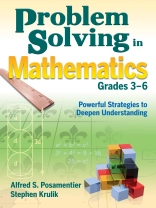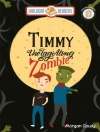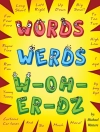‘Demonstrates problem solving strategies with solutions and teaching notes and allows the teacher to create a collection of problems to fit a particular grade level.’
—Janice L. Richardson, Associate Professor and Education Coordinator, Department of Mathematics
Elon University
Help students succeed as problem solvers in and out of the classroom!
Problem solving skills are critical to students′ success in mathematics, but the techniques can′t be caught; they must be taught. Based on the premise that educators must take a deliberate approach to the teaching of problem solving skills, this book helps teachers engage students in the process.
Problem Solving in Mathematics, Grades 3–6 stresses the importance of problem solving in mathematics and presents nine strategies that students can use to solve problems, such as working backwards, finding a pattern, making a drawing, or solving a simpler equivalent problem. Each chapter demonstrates how teachers can:
- Apply the strategies to problems at different grade levels
- Incorporate these strategies into a mathematics program
- Understand how each strategy can be applied to real-life situations
- Make each strategy an integral part of students′ thinking processes
With helpful teaching notes, sample problems for students that fit into any mathematics curriculum, and step-by-step solutions to sample problems, this book is perfect for teachers who want their students to succeed in mathematics!
Table of Content
Acknowledgments
About the Authors
Preface
1. An Introduction to Problem Solving
2. Organizing Data
Applying the Organizing Data Strategy
Teaching Notes
Problems for Students
3. Intelligent Guessing and Testing
Applying the Intelligent Guessing and Testing Strategy
Teaching Notes
Problems for Students
4. Solving a Simpler Equivalent Problem
Applying the Solving a Simpler Equivalent Problem Strategy
Teaching Notes
Problems for Students
5. Acting It Out or Simulation
Applying the Acting It Out or Simulation Strategy
Teaching Notes
Problems for Students
6. Working Backwards
Applying the Working Backwards Strategy
Teaching Notes
Problems for Students
7. Finding a Pattern
Applying the Finding a Pattern Strategy
Teaching Notes
Problems for Students
8. Logical Reasoning
Applying the Logical Reasoning Strategy
Teaching Notes
Problems for Students
9. Making a Drawing
Applying the Making a Drawing Strategy
Teaching Notes
Problems for Students
10. Adopting a Different Point of View
Applying the Adopting a Different Point of View Strategy
Teaching Notes
Problems for Students
Readings on Problem Solving
About the author
Stephen Krulik is professor of mathematics education at Temple University in Philadelphia, where he is responsible for the undergraduate and graduate preparation of mathematics teachers for Grades K-12, as well as in the inservice training of mathematics teachers at the graduate level. He teaches a wide variety of courses, among them the History of Mathematics, Methods of Teaching Mathematics, and the Teaching of Problem Solving. Before coming to Temple University, he taught mathematics in the New York City public schools for 15 years, where he created and implemented several courses designed to prepare students for the SAT examination. Nationally, Krulik has served as a member of the committee responsible for preparing the Professional Standards for Teaching Mathematics of the National Council of Teacher of Mathematics (NCTM). He was also the editor of the NCTM’s 1980 yearbook Problem Solving in School Mathematics. He is the author or co-author of more than 20 books for teachers of mathematics, including Assessing Reasoning and Problem Solving: A Sourcebook for Elementary School Teachers. He has served as a consultant to and has conducted many workshops for school district throughout the United States and Canada, as well as delivering major presentations in Austria, Hungary, Australia, and international professional meetings, where his major focus is on preparing all students to reason and problem-solve in their mathematics classroom, as well as in their lives. Krulik received his BA degree in mathematics from Brooklyn College of the City University of New York, and his MA and Ed D in mathematics education from Columbia University’s Teachers College.












